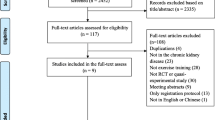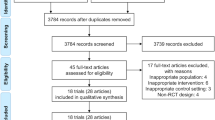Abstract
Objective
To investigate the efficacy of exercise training on functional capacity and quality of life in chronic kidney disease.
Data sources
SCOPUS, CINAHL, Science Direct, Web of Science, MEDLINE, ProQuest, Physiotherapy Evidence Database (PEDRO), and Google Scholar databases were searched between 2010 and December 2020.
Methods
Randomized controlled trials were included if they involved any types of exercise training (aerobic, resisted and respiratory ex.) conducted with chronic kidney disease patients. Three authors independently screened articles, extracted data, and assessed the methodological quality using PEDro scale, and two authors released any confliction. Modified Sackett Scale was used to determine the level of evidence for each outcome.
Results
Out of 130 papers screened, 13 studies with 619 participants met the inclusion criteria. The frequency of the treatment ranged from three to four sessions per week for a period ranging from 8 to 24 weeks. According to the Pedro scale, the quality of studies ranged from good (three studies) to fair (ten studies). All included studies showed positive effects on the measured outcomes (functional capacity and quality of life in chronic kidney disease).
Conclusion
Exercise programs for chronic kidney disease patients provide beneficial clinical outcomes and optimize functional capacity and quality of life in those patients. Future studies still need to focus on high-quality evidence and studies evaluating the adverse effects of exercise.

Similar content being viewed by others
References
Steenbergen K, Mackenzie L (2004) Professional support in rural New South Wales: perceptions of new graduate occupational therapists. Aust J Rural Health 12(4):160–165
Kalantar-Zadeh K, Block G, Humphreys MH, Kopple JD (2003) Reverse epidemiology of cardiovascular risk factors in maintenance dialysis patients. Kidney Int 63(3):793–808
Almutairi FM, Al-Duais MA, Shalaby KA, Sakran MI (2017) Analysis of patients with end-stage renal disease on dialysis in Tabuk City, Saudi Arabia: a single-center, three-year retrospective study. Saudi J Kidney Dis Transpl 28(2):349–354
Johansen KL (2007) Exercise in the end-stage renal disease population. J Am Soc Nephrol 18(6):1845–1854
Kalantar-Zadeh K, Kilpatrick RD, McAllister CJ, Greenland S, Kopple JD (2005) Reverse epidemiology of hypertension and cardiovascular death in the hemodialysis population: the 58th annual fall conference and scientific sessions. Hypertension 45(4):811–817
Zelle DM, Klaassen G, Van Adrichem E, Bakker SJ, Corpeleijn E, Navis G (2017) Physical inactivity: a risk factor and target for intervention in renal care. Nat Rev Nephrol 13(3):152–168
Bauman AE, Reis RS, Sallis JF, Wells JC, Loos RJ, Martin BW et al (2012) Correlates of physical activity: why are some people physically active and others not? Lancet 380(9838):258–271
Suliman M, Stenvinkel P, Qureshi AR, Kalantar-Zadeh K, Barany P, Heimbürger O et al (2006) The reverse epidemiology of plasma total homocysteine as a mortality risk factor is related to the impact of wasting and inflammation. Nephrol Dial Transplantat 22(1):209–217
Ouzouni S, Kouidi E, Sioulis A, Grekas D, Deligiannis A (2009) Effects of intradialytic exercise training on health-related quality of life indices in haemodialysis patients. Clin Rehabil 23(1):53–63
Hawamdeh S, Almari AM, Almutairi AS, Dator WLT (2017) Determinants and prevalence of depression in patients with chronic renal disease, and their caregivers. Int J Nephrol Renovasc Dis 10:183–189
Johnson N, Phillips M (2018) Rayyan for systematic reviews. J Electron Resour Librariansh 30(1):46–48
Maher CG, Sherrington C, Herbert RD, Moseley AM, Elkins M (2003) Reliability of the PEDro scale for rating quality of randomized controlled trials. Phys Ther 83(8):713–721
Valkenet K, van de Port IG, Dronkers JJ, de Vries WR, Lindeman E, Backx FJ (2011) The effects of preoperative exercise therapy on postoperative outcome: a systematic review. Clin Rehabil 25(2):99–111
Straus SE, Richardson W, Glasziou P, Haynes R (2005) How to practice and teach EBM. Evid Bas Med, 3rd edn. Elservier, pp 13–29
Abdelaal AAM, Abdulaziz EM (2019) Effect of exercise therapy on physical performance and functional balance in patients on maintenance renal hemodialysis: randomized controlled study. J Exerc Rehabil 15(3):472–480
Aoike DT, Baria F, Kamimura MA, Ammirati A, Cuppari L (2018) Home-based versus center-based aerobic exercise on cardiopulmonary performance, physical function, quality of life and quality of sleep of overweight patients with chronic kidney disease. Clin Exp Nephrol 22(1):87–98
de Lima MC, de Cicotoste CL, da Cardoso KS, Forgiarini LA Jr, Monteiro MB, Dias AS (2013) Effect of exercise performed during hemodialysis: strength versus aerobic. Ren Fail 35(5):697–704
Fernandes ADO, Sens YADS, Xavier VB, Miorin LA, Alves VLDS (2019) Functional and respiratory capacity of patients with chronic kidney disease undergoing cycle ergometer training during hemodialysis sessions: a randomized clinical trial. Int J Nephrol 2019:7857824
Figueiredo PHS, Lima MMO, Costa HS, Martins JB, Flecha OD, Gonçalves PF et al (2018) Effects of the inspiratory muscle training and aerobic training on respiratory and functional parameters, inflammatory biomarkers, redox status and quality of life in hemodialysis patients: a randomized clinical trial. PLoS ONE 13(7):e0200727
Frih B, Jaafar H, Mkacher W, Ben Salah Z, Hammami M, Frih A (2017) The effect of interdialytic combined resistance and aerobic exercise training on health related outcomes in chronic hemodialysis patients: the Tunisian randomized controlled study. Front Physiol 8:288
Frih B, Mkacher W, Bouzguenda A, Jaafar H, Alkandari SA, Salah ZB et al (2017) Effects of listening to Holy Qur’an recitation and physical training on dialysis efficacy, functional capacity, and psychosocial outcomes in elderly patients undergoing haemodialysis. Libyan J Med 12(1):1372032
Jamshidpour B, Bahrpeyma F, Khatami M-R (2020) The effect of aerobic and resistance exercise training on the health related quality of life, physical function, and muscle strength among hemodialysis patients with Type 2 diabetes. J Bodyw Mov Ther 24(2):98–103
Lazarus ER (2019) Effectiveness of education and exercise on quality of life among patients undergoing hemodialysis. Clin Epidemiol Glob Health 7(3):402–408
Marchesan M, Nunes VGDS, Rombaldi AJ (2014) Physical training improves physical fitness and the quality of life of patients on hemodialysis. Rev Bras Cineantropom Desempenho Hum 16(3):334–344
Nilsson BB, Bunæs-Næss H, Edvardsen E, Stenehjem A-E (2019) High-intensity interval training in haemodialysis patients: a pilot randomised controlled trial. BMJ Open Sport Exerc Med 5(1):e000617
Pellizzaro CO, Thomé FS, Veronese FV (2013) Effect of peripheral and respiratory muscle training on the functional capacity of hemodialysis patients. Ren fail 35(2):189–197
Rosa CSDC, Nishimoto DY, Souza GDE, Ramirez AP, Carletti CO, Daibem CGL et al (2018) Effect of continuous progressive resistance training during hemodialysis on body composition, physical function and quality of life in end-stage renal disease patients: a randomized controlled trial. Clin Rehabil 32(7):899–908
Matsufuji S, Shoji T, Yano Y, Tsujimoto Y, Kishimoto H, Tabata T et al (2015) Effect of chair stand exercise on activity of daily living: a randomized controlled trial in hemodialysis patients. J Ren Nutr 25(1):17–24
Kosmadakis GC, Bevington A, Smith A, Clapp E, Viana J, Bishop N et al (2010) Physical exercise in patients with severe kidney disease. Nephron Clin Pract 115(1):c7–c16
Ikizler TA, Pupim LB, Brouillette JR, Levenhagen DK, Farmer K, Hakim RM et al (2002) Hemodialysis stimulates muscle and whole body protein loss and alters substrate oxidation. Am J Physiol Endocrinol Met 282(1):E107–E116
Brown PDS, Rowed K, Shearer J, MacRae JM, Parker K (2018) Impact of intradialytic exercise intensity on urea clearance in hemodialysis patients. Appl Physiol Nut Metab 43(1):101–104
Sheng K, Zhang P, Chen L, Cheng J, Wu C, Chen J (2014) Intradialytic exercise in hemodialysis patients: a systematic review and meta-analysis. Am J Nephrol 40(5):478–490
Huang M, Lv A, Wang J, Xu N, Ma G, Zhai Z et al (2019) Exercise training and outcomes in hemodialysis patients: systematic review and meta-analysis. Am J Nephrol 50(4):240–254
Cheema B, Abas H, Smith B, O’Sullivan A, Chan M, Patwardhan A et al (2007) Progressive exercise for anabolism in kidney disease (PEAK): a randomized, controlled trial of resistance training during hemodialysis. J Am Soc Nephrol 18(5):1594–1601
DePaul V, Moreland J, Eager T, Clase CM (2002) The effectiveness of aerobic and muscle strength training in patients receiving hemodialysis and EPO: a randomized controlled trial. Am J Kidney Dis 40(6):1219–1229
Headley S, Germain M, Mailloux P, Mulhern J, Ashworth B, Burris J et al (2002) Resistance training improves strength and functional measures in patients with end-stage renal disease. Am J Kidney Dis 40(2):355–364
Kouidi E, Albani M, Natsis K, Megalopoulos A, Gigis P, Guiba-Tziampiri O et al (1998) The effects of exercise training on muscle atrophy in haemodialysis patients. Nephrol Dial Transplant 13(3):685–699
Wu X, Yang L, Wang Y, Wang C, Hu R, Wu Y (2020) Effects of combined aerobic and resistance exercise on renal function in adult patients with chronic kidney disease: a systematic review and meta-analysis. Clin Rehabil 34(7):851–865
Heiwe S, Jacobson SH (2011) Exercise training for adults with chronic kidney disease. Cochrane Database Syst Rev (10):CD003236. https://doi.org/10.1002/14651858.CD003236.pub2
Ibrahim AA, Althomali OW, Hussein HM, Atyia MR, Eldesoky MT, Gamal M, Abdelbasset WK (2021) Physical and psychological response to exercise training in chronic kidney disease patients: a quasi-randomized controlled trial. Med Sci 25(109):547–555
Mustata S, Groeneveld S, Davidson W, Ford G, Kiland K, Manns B (2011) Effects of exercise training on physical impairment, arterial stiffness and health-related quality of life in patients with chronic kidney disease: a pilot study. Int Urol Nephrol 43(4):1133–1141
Perlman RL, Finkelstein FO, Liu L, Roys E, Kiser M, Eisele G et al (2005) Quality of life in chronic kidney disease (CKD): a cross-sectional analysis in the Renal Research Institute-CKD study. Am J Kidney Dis 45(4):658–666
Heiwe S, Jacobson SH (2014) Exercise training in adults with CKD: a systematic review and meta-analysis. Am J Kidney Dis 64(3):383–393
Barcellos FC, Santos IS, Umpierre D, Bohlke M, Hallal PC (2015) Effects of exercise in the whole spectrum of chronic kidney disease: a systematic review. Clin Kidney J 8(6):753–765
Acknowledgements
This research has been funded by Scientific Research Deanship at University of Ha’il—Saudi Arabia, through project number RG-191348.
Funding
University of Ha’il.
Author information
Authors and Affiliations
Corresponding author
Ethics declarations
Conflict of interest
The authors have no conflict of interest.
Additional information
Publisher's Note
Springer Nature remains neutral with regard to jurisdictional claims in published maps and institutional affiliations.
Rights and permissions
About this article
Cite this article
Ibrahim, A.A., Althomali, O.W., Atyia, M.R. et al. A systematic review of trials investigating the efficacy of exercise training for functional capacity and quality of life in chronic kidney disease patients. Int Urol Nephrol 54, 289–298 (2022). https://doi.org/10.1007/s11255-021-02917-4
Received:
Accepted:
Published:
Issue Date:
DOI: https://doi.org/10.1007/s11255-021-02917-4




